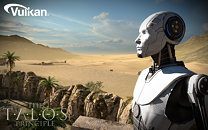Tuesday, February 16th 2016

NVIDIA Talks Vulkan, Supports it on "Kepler" and "Maxwell" GPUs
NVIDIA talked Vulkan in its latest GeForce blog post, announcing that your GeForce GTX graphics card already supports the "industry forged" API. NVIDIA is offering Vulkan hardware-acceleration on its "Kepler" and "Maxwell" GPU architectures at this time, and on Windows 7 and above; PC Linux, and Android. NVIDIA is all praises for Vulkan's low-latency and high-efficiency pathways, which streamline the process of drawing graphics.
Vulkan makes its big mainstream debut with a major update to "The Talos Principle," by Croteam (the people behind the "Serious Sam" franchise). This update adds a Vulkan renderer to the game, and ships later today. NVIDIA has an driver ready with the Vulkan API, which you can download from here. Maintained by the Khronos Group, Vulkan is a successor to OpenGL, although it's built from the ground up, with a major chunk of its code being contributed by AMD, from its Mantle API.
Source:
NVIDIA Blog
Vulkan makes its big mainstream debut with a major update to "The Talos Principle," by Croteam (the people behind the "Serious Sam" franchise). This update adds a Vulkan renderer to the game, and ships later today. NVIDIA has an driver ready with the Vulkan API, which you can download from here. Maintained by the Khronos Group, Vulkan is a successor to OpenGL, although it's built from the ground up, with a major chunk of its code being contributed by AMD, from its Mantle API.

20 Comments on NVIDIA Talks Vulkan, Supports it on "Kepler" and "Maxwell" GPUs
developer.nvidia.com/vulkan-driver
support.amd.com/en-us/kb-articles/Pages/Radeon-Vulkan-Beta.aspx
because
Today the Khronos Group announced immediate public release of the open standard and cross-platform Vulkan™ 1.0 graphics API
As a complement to OpenGL™, descended from AMD's Mantle, and forged by the industry, Vulkan™ is a powerful low-overhead graphics API designed for developers who want or need deeper hardware control over GPU acceleration. Vulkan™ gives software developers control over the performance, efficiency, and capabilities of Radeon™ GPUs and multi-core CPUs.
I think you have to read it again,
never does it say Nvidia did anything other then making sure it works on their hardware.
"NVIDIA has worked closely with the Khronos Group, the creators of Vulkan, throughout its development, and as of today all Kepler and Maxwell graphics card running Windows 7 or later, or Linux, are supported by Vulkan."
and obviously Nvidia would never mention let alone give praise to AMD, they are their enemy yo.
The Talos Principle Vulkan FAQ
I have him on ignore but it doesn't work on links from the main page on mobile.
amd also hasbeta driver to support vulkan .
when AMD announce Mantle, Nvidia simply keep silent, but now that Mantle handed to Khronos and reincarnate to Vulkan
Nvidia simply say our GPU support Vulkan
It sounds like there's a big API shift a-coming. And it sounds like even M$ won't be able to stop it this time (F you DX).
"Vulkan™ is an open standard and cross-platform Application Programming Interface (API) developed by the Khronos™ Group. Derived from AMD’s revolutionary Mantle API"
Also DX12 is another repackaging of AMD API:
BTW, remember all the fanboys which claimed that AMD would rock Vulkan because it "was just Mantle" and Nvidia would struggle, well Nvidia managed to create the first driver which has been usable for months. Nvidia managed to create the first demo almost one year ago. And if Vulkan was Mantle then AMD would have showed a great advantage, an advantage which we now know for sure doesn't exist.That is utterly untrue. As Nvidia said "Our work with Microsoft on DirectX 12 began more than four years ago".
Mantle was AMDs side project while waiting for Direct3D 12, the core features was planned in 2010/2011. Mantle was one source of input during formalizing Direct3D 12, which is the reason why some basic generic function calls are the same. But any programmer would know that this does not make the underlying API the same.
Only a fool would believe that AMD and Nvidia managed to add the right hardware features for Direct3D 12 years in advance without planning for it.